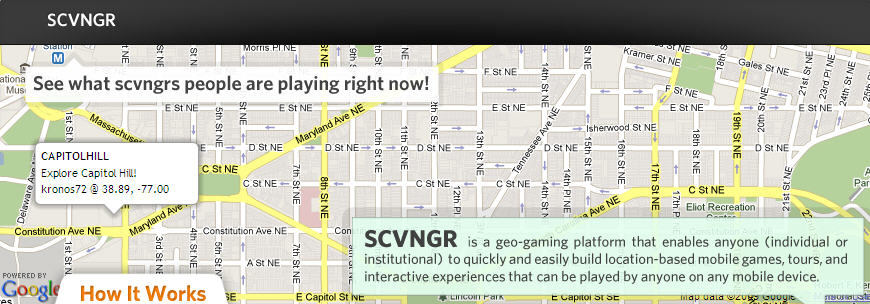This resource builds off an earlier post in Aug 2008 about ‘Crafty Toys’, but has been translated into a page to encompass new additions.
** Last updated: 19th Aug 2010 **
See also Jeff Watson’s post on tools for social media ARG updates, created on 9th Feb 2010
It is a resource listing technologies used to manage cross/trans/multi-platform/media projects. I’m not talking about cross-media measurement, but about the tools you can use to deliver and manage your content across media platforms. I’ve selected a range of technologies used in alternate reality games, pervasive games, location-based games and interactive TV:

Xenophile Media’s ‘Reactor Engine’
Xenophile describe the Reactor CMDS (Content Management and Deployment System) as proprietary software to assist the deployment of their alternate reality games. Here is their description from their website:
REACTOR deploys ARG game content according to a dynamic schedule creating the sense tht events in the television series affect events in the game world. REACTOR then tracks the progress of every registered player, creating a customized experience, bringing in-game characters to life using artifical intelligence to simulate communication through email, SMS, instant messages and chat.
As you can see from the player-side interface to the ReGenesis Extended Reality Game II, the player sees data they receive on each mission and this information stays there, being added to with each visit. The missions were delivered via email, with an auto-responder program. I understand the need for auto-responders in large-scale projects, but I found it a real let down after I had spent a long time writing my mission. But as I said, I understand the need. One cannot forget, however, how important and effective personalisation can be. A simple: ‘Dear Christy’ would of gone a long way. [this may be the case with their current games.]
The system is especially relevant to Xenophile’s projects as their TV-related work is often re-sold into new territories. This means they need to geo-lock the websites. They also control of access to game sites with passwords, which means only those who have already registered to play the games can see the content of the websites. This move ensures that it doesn’t get confused with real life content and helps to track player actions. See my previous discussion about how ARGs cue their fictionality for more on the need to make fictionality clear.
Hoodlum Digital Entertainment’s ‘INCA’
INCA (Interactive Net-based Channel Administration) is described at Hoodlum’s website as follows:
HOODLUM has created a unique content management and delivery system that allows content to be delivered across all defined platforms in an automated process. This proprietary technology has been developed as a tool in Hoodlum’s projects Fat Cow Motel, PS TRIXI, The Emmerdale Online Channel, Spooks Interactive and Find 815. The system and its application continues to be implemented as an effective way to process, automate and deliver narrative based content within this environment. Hoodlum will continue to evolve our technology, aiming to remove barriers to entry in the digital space.
You can see the player-side interface in these two examples:
Find 815
Emmerdale Online
Sarah Perez of ReadWriteWeb adds that ‘there are modules like user management, content management, approvals, game engine, characters, and scripts – all of which combine to run the game’ [source]. As you can see from Hoodlum’s projects, the player-side software is designed to make the online narratives as accessible as possible to online entertainment newcomers. It appears they’re having great success in addressing these audiences (which is usually targeting the TV show fans, rather than fans or non-fans with online entertainment experience).
Fourth Wall Studios’ RIDES

There isn’t much information on their website, but it is described as a “proprietary technology that links all these things together” (phone, computer, email). I presume it was the technology used to deploy their Watchmen Experience and so is similiar to Seize the Media’s web and phone technology.
Seize the Media’s MIG
Seize the Media is filmmaker Lance Weiler’s company that creates and develops entertainment technologies. They created MIG (media integrated gameplay) for his Head Trauma which included a phone-and-web experience. For people who attended a ‘cinema ARG’ event for Head Trauma, there was the opportunity to provide your cell phone number. Those that did received messages during the movie in the theatre. But the experienced continued at home. They were sent SMSes and a special invite to a particular part of the online comic. Once there, the system knew where they were in the comic and had the main character call them. According to their answers (yes or no), certain audio and visual assets were triggered online. They even recorded what people answered to questions such as ‘tell me something no-one else knows’, and then played that repeatedly on the site. They also created a fake exit icon, and so when people clicked on it the system knew they were wanted to close the page. The character then said to them: ‘Where do you think you’re going? We’re not finished yet.’ All this was discussed in the vodcast with Lance Weiler here.
Fuji Australia’s XMPie VDP Technology
The XMPie VDP acronym stands for variable-data-publishing, and is specially designed for personalisation and has a cross-media publishing facility. Now, this is one of my favourites because it involves three media, simultaneously. Fuji Australia created a special mini ‘Be A Superhero’ experience to market it (which I spoke about on my previous blog). So you can test it out yourself. If you’re putting in your mobile number internationally (outside of Australia), then put in your country code (no ‘+’ needed) and your mobile number without the ‘0’ at the beginning.
XMPIE
Transmedia Storyteller is about to go into Beta, and will begin with social media deployment tools.
Flux Singularity
This project is about to move into Beta.
The Creator
The Creator is the next version of the Game Creator (which was an iPerG developed technology), and used in Sweden’s multi-platform project ‘The Truth About Marika’ by company P. It is described on the project website as follows:
The Creator is a web based authoring (game creation) and orchestration (runtime) for games that is played in the physical domain. The aim is to create a collaborative tool for game designers, producers and developers to work with the content, rules and structure of their game.
‘Ordo Serpentis’ was the name of the web-based technology on the player’s side, and GameCreator the ‘game mastering’ technology. Game Creator enabled the designers to control the pacing of the game by issuing missions and messages to the players. I have some more information about how the technology was used in The Truth About Marika, and some images, but that info is in a document that has not been publicly released yet. So, here is some information at iPerG from the past interations of the technology:
Game Mastering interface of previous iteration, from ‘Game Tutorial’ [PDF]
The core concepts are
– The assets, comprising media that the system can output and real-world places
and triggers that the system can recognise.
– The game objects, comprising the places, objects and people that the game
logic is about. Game objects have parameters that change during the course of
the game.
– The game events, which translate the real world triggers (e.g reading an RFID
tag) to a meaningful game event (e.g. visiting a game location or being close to
another player).
– The actions, listing the things the system can output, which differ depending
on the kind of device that the player carries.source: Final Report, Boxed Pervasive Games [PDF]
Integrated Project on Pervasive Gaming’s (iPerG) Solution Packages
At the end of their projects, iPerG share development kits for pervasive games. As they explain on their site, the ‘packages are mainly targeted at software developers, and also contain documentation describing how the components can be used in unison to produce a pervasive game, along with code samples and tutorial guides’.
- The AR based games solution package. This package targets pervasive games based on an augmented reality metaphor. The main software component is the Morgan AR/VR platform, but other components include the Logfile Analysis tool and the Polling tool .
- The mobile phones based games solution package. This package targets pervasive games where players use mobile phones as their main input and output device, supported by a server backend. The main software component is the MUPE platform, but other components include the Web Application Framework.
- The ubicomp based games solution package . This package targets pervasive games based on ubiquitous computing principles, embedded processors and the use of sensor and actuator hardware. The main software component is a Java gaming library, based on the PIMP and PART platforms, but other components include the Logfile Analysis tool and the Polling tool.
[Make sure you also check out the various reports iPerG put out over the last few years.]
Cipher Cities Game Builder
Australian project Cipher Cities is also a technology for pervasive games. But it is a free technology that enables people to create their own location-based games. It is based on Newish Media’s SCOOT CAMP.
Early iteration of Cipher Game Builder
Crossroads: the Reality Games Engine
Crossroads is the flexible solution for storytelling across multiple media channels, using technology already a part of the player’s life, such as cell phones, web pages and news feeds, to make the story come alive. Literally.
Player tracking
The Crossroads engine tracks the player’s progression through the game, and serves up the right dialogue or media asset at the right time and place:Dialogue-driven interaction
The player’s interaction with the game is in part based on dialogue between the player and the fictional characters of the game. This pushes the momentum of the story literally out in the streets, where the player’s tasks are played out. SMS is used for this communication, allthough MMS, email and voicemail is also supported.Common Technology
This use of common technology strenghtens the game’s grip on the player, and makes it accessible without installing any software or hardware.Mission control
A game can also be provided with a web-based dashboard to help the player keep track of current missions, real-time story progression and character profiles. Utilizing a user-friendly interface the mission is visualized through innovative use of Google maps, and media playback and management. This dashboard can be provided for both browser-based and mobile platforms.Live events
Crossroads also enables scripted in-game events and live performances. These events can be triggered by the player’s presence in a certain location, by using RFID and AR-technology to track the player’s movement in the physical environment.
Our powerful web-based toolkit enables institutions and individuals to easily build sophisticated, multimedia, fully-interactive mobile experiences and instantly deploy them to every mobile device on any carrier. No tech skills required. Build yours today!
Design, Create and Play Location-Based Games and Simulations using the STEP AR Engine and Toolkit. The Beta version 6.0 of the AR toolkit is now available free of charge for educational, non-profit purposes. The .zip file (10 MB) contains software for your GPS-enabled Windows Mobile PDA, a Windows desktop AR Editor to create or modify AR games, and documentation.
Ideltech’s ARGm (no-longer in development)
The ARG Manager is Ideltech’s key software offering. It is designed to help organize and simplify the process of developing and running an Alternate Reality Game.
Instead of worrying each day of your game about FTP logins, uploading site updates, and editing HTML, you can set up your sites to use ARGm. Then site updates can be accomplished with a click of the mouse or even completely automatically! You can concentrate on worrying about that news article for tomorrow that isn’t done and how to guide your blockheaded players through the easiest puzzle of the game that they’re stuck on. Check the features page to get a better idea of what ARGm will be able to do for you.
Play Area-Code’s Broadcast-web-game-sync technology
Play Area-Code describe the project and technology as follows:
The Sopranos A&E Connection game was designed for the premiere of the Sopranos on A&E TV. Using cell phones to collect pieces, players composed a online gameboard to anticipate what might happen that night on the Sopranos, much like Fantasy Football works with sports.
When the episode premieres on A&E, the players’ online gameboards come to life and animate synchronously to the TV signal. As the characters, settings and objects of the Sopranos appear on TV, the corresponding pieces animate and score points. This represents the first time a game was ever designed wholly for synchronous two-screen entertainment. [source]
I’m not sure if it is the first. One cannot forget the pivotal project by Spiderdance in 1999. ‘webRIOT‘ was MTV’s first iTV program and it was (apparently!), the world’s first TV show specifically designed for two-screen interaction. And, guess who was a designer? Drum roll…Tracey Fullerton! Yes, I’ve known about this for a while and have been quite chuffed that Tracey has a cross/trans/multi-media past. 🙂
And then there is of course the many mobile/cell phone to paper/magazine/billboard/phone etc technologies emerging. Many are created for advertisers (like the XMPIE) but that doesn’t mean they can’t be used for stories and games! Examples include blutooth for video distribution (as Channel 4 showed us with the Viacom poster project as few years back; and more recently with the Big Brother campaign in Australia); QRCode, like the one used in the Pet Shop Boys’s ‘Integral’ video; Semacode; mcode; Mobot; ColorZip; RFID; NFC and so on.
Ah, so many crafty toys to play with and come up with great experiences (although my dream of a media integrated home entertainment system is still a bit off — hint hint…I want to develop projects in cool labs like that).
Do you have any technologies that you know of you can share? I’d love to hear about them.








2 Replies